Mass Spectrometry Facility
The Mass Spectrometry Facility at Keele University is run in collaboration with Guy Hilton Research Centre (GHRC) and the Robert Jones and Agnes Hunt Orthopaedic Hospital (RJAH) in Oswestry. We provide proteomics and mass spectrometry services for UK based researchers, engage in research collaborations and implement current technologies in facility services.
Keele has invested in a variety of mass spectrometers with complementary analytical capabilities, together with HPLC equipment to provide upstream separation for enhanced sensitivity and automation.
Keele’s mass spectrometry facilities are housed across two adjacent buildings on the main Campus site: in the Huxley Building (School of Life Sciences) and the Lennard Jones Laboratories (School of Chemical and Physical Sciences).
There are a number of groups using mass spectrometry as their primary analytical method.
Huxley Building
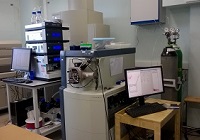 The Waters QTof Premier us used for both peptide characterisation and intact protein work. It is capable of performing both qualitative analysis and quantitative analysis (via selection of appropriate stable isotope-labelled standards or use of iTRAQ/TMT labelling of proteolytic digests). It is equipped with a dedicated nanoflow HPLC (Ultimate 3000) for separation and cleanup of samples online with nanospray.
The Waters QTof Premier us used for both peptide characterisation and intact protein work. It is capable of performing both qualitative analysis and quantitative analysis (via selection of appropriate stable isotope-labelled standards or use of iTRAQ/TMT labelling of proteolytic digests). It is equipped with a dedicated nanoflow HPLC (Ultimate 3000) for separation and cleanup of samples online with nanospray.
For further information on this instrument please contact Sarah Hart
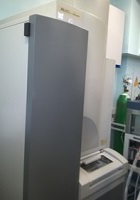 The AB Sciex 4800 ToF/ToF instrument is primarily used for characterisation of semi-complex mixtures from protein digests, although it is also capable of intact protein and small molecule analyses. This instrument can do both intact mass characterisation (MS) and product ion analysis (MS/MS), which can be used to determine (for instance) peptide sequence hence to confer protein identity. We have a dedicated nanoflow HPLC with spotter robot (Ultimate 3000, NanoMate), which is used for separating complex mixtures and spotting MALDI targets.
The AB Sciex 4800 ToF/ToF instrument is primarily used for characterisation of semi-complex mixtures from protein digests, although it is also capable of intact protein and small molecule analyses. This instrument can do both intact mass characterisation (MS) and product ion analysis (MS/MS), which can be used to determine (for instance) peptide sequence hence to confer protein identity. We have a dedicated nanoflow HPLC with spotter robot (Ultimate 3000, NanoMate), which is used for separating complex mixtures and spotting MALDI targets.
For further information on this instrument please contact Sarah Hart
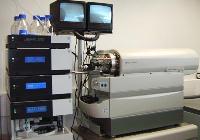 The AB Sciex ESI 3200-QTRAP is a tandem quadrupole instrument primarily used for targeted quantitative analysis of known compounds via selected ion monitoring, selected reaction monitoring and multiple reaction monitoring, although the final segment is a linear ion trap capable of performing product ion analysis. It is equipped with nanoflow HPLC (DIonex Ultimate 3000) for separation of mixtures.
The AB Sciex ESI 3200-QTRAP is a tandem quadrupole instrument primarily used for targeted quantitative analysis of known compounds via selected ion monitoring, selected reaction monitoring and multiple reaction monitoring, although the final segment is a linear ion trap capable of performing product ion analysis. It is equipped with nanoflow HPLC (DIonex Ultimate 3000) for separation of mixtures.
For further information on this instrument please contact Sarah Hart
We have semi-preparative HPLC which can be used for ion exchange, reversed-phase and HILIC separation of complex mixtures prior to LC-MS/MS analysis (Dionex Ultimate 3000), with both UV and fluorescence detection.
We have a full suite of mass spectrometry/proteomics software (Mascot, Scaffold Q+, PEAKS), which can be used to interrogate proteomics datasets generated on multiple analytical platforms from different vendors.
We also have access to a full range of equipment for biochemical analysis of various types in the Harvey Laboratories.
For further information on this instrument please contact Sarah Hart
Lennard-Jones Laboratories
The Waters ZQ is a single quadrupole instrument with a mass range up to 2000D. Whilst we do have an electrospray source for this instrument for comparative purposes, it is normally set up for ambient mass spectrometry in the form of PADI-MS. For this technique a cold (He-) plasma source is replacing the ESI source, allowing direct analysis of solids and liquids without prior sample preparation.
The Thermo LTQ-Orbitrap instrument is on loan from AstraZeneca for collaborative work to investigate the use of ambient mass spectrometry in the form of PADI-MS for rapid analysis of a range of pharmaceutically relevant samples. The instrument is as standard equipped with an electrospray source, which can rapidly be replaced by a low temperature (He-) plasma source for PADI-MS operation. In this technique the plasma is used to directly ionise and volatilise the analyte without prior sample preparation. The LTQ-Orbitrap has a choice of linear quadrupole trap for tandem MS and highly sensitive detection, with an Orbitrap facility should high mass resolution be required.
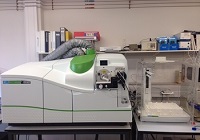
The NexION 300D represents the current generation of ICP-MS instrumentation, it is capable of measuring single or multiple elements in a single analysis down to part-per-trillion concentrations. This particular model is equipped with a Universal Cell that can be used to remove isobaric interferences using either a reactive or non-reactive gas. This instrument can be configured for both conventional infusion and elemental speciation analysis.
For a video describing the operation of this instrument see: https://www.youtube.com/watch?v=L-FYh2z9mi0
For further information on this instrument please contact David Thompson
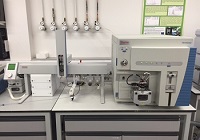 The ThermoFisher TSQ Vantage can be used for the structural determination and quantification of a wide range of molecules. It is equipped with an Ion Max source and a Heated Electrospray (HESI) source, this is coupled to a dedicated ThermoFisher LC system complete with a temperature controlled autosampler.
The ThermoFisher TSQ Vantage can be used for the structural determination and quantification of a wide range of molecules. It is equipped with an Ion Max source and a Heated Electrospray (HESI) source, this is coupled to a dedicated ThermoFisher LC system complete with a temperature controlled autosampler.
For further information on this instrument please contact David Thompson or see: http://www.textronica.com/lcline/vantage_spec_sheet.pdf
Contact us

Dr Falko Drijfhout
Senior Lecturer in Analytical Chemistry
- Lennard-Jones: 1.36
- +44 (0)1782 733043
- f.drijfhout@keele.ac.uk
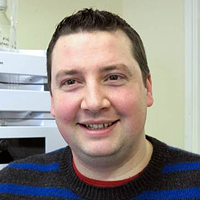
Dr David Thompson
Lecturer in Forensic and Analytical Chemistry
- Lennard-Jones: 1.49
- +44 (0)1782 734954
- d.f.thompson@keele.ac.uk
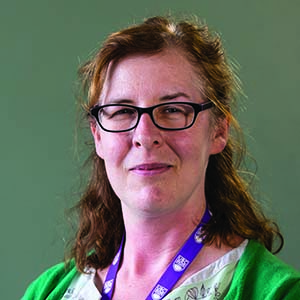
Dr Sarah Hart
Senior Lecturer in Bioscience
- +44 (0) 1782 733759
- s.r.hart@keele.ac.uk

